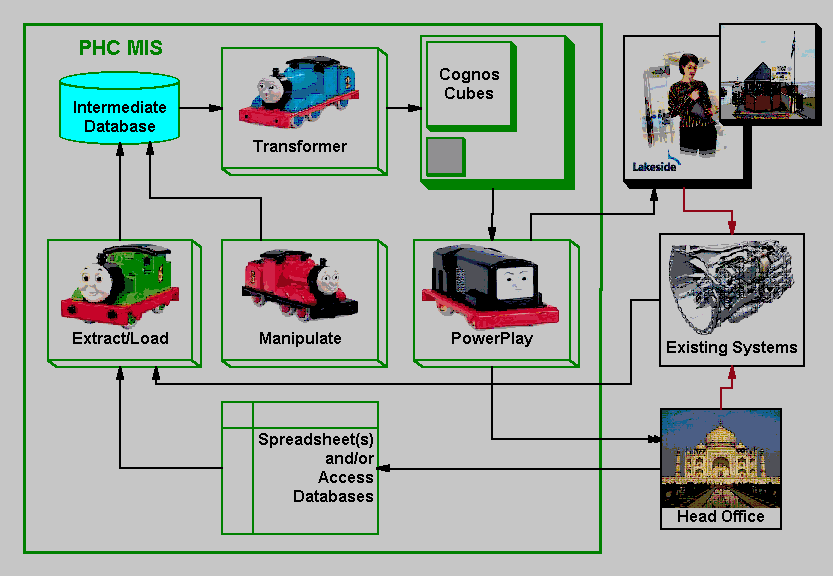Pleasance House Consulting - Management
Information System
Multiple retailers have a variety of sales outlets, warehouses etc. producing data that is fed into a set of central systems that are specifically designed as operational, transaction-processing tools. These systems may be extremely efficient at helping run the business on a day-to-day basis, but their internal data structures make them poor providers of summary-level management information. Operational reports are incapable of providing a clear view of longer-term trends and can be difficult to produce in the required summary format. Reports produced from financial ledgers frequently do not match reports from central merchandising systems.
The PHC Management Information System overcomes these problems by collecting low-level data from the operational systems and processing it into an intermediate database (data warehouse) specifically designed to feed the reporting requirements of that particular retail enterprise. A key part of this processing is the re-classification of low-level data into additional structures that may not be supported in the operational systems. The Extract/Load "engine" gathers transaction records and structural data from existing systems and extra data sources and loads it into the intermediate database in fairly 'raw' format.

The Manipulate "engine" checks the integrity of the data, fixing known problems and reporting on what it has done. It performs any re-classification exercises required to meet the reporting requirements. It manages changes in reference data, for instance stores that were 'New' will be changed to 'Like-for-Like' when they have been trading for a full year. It consolidates the data into the most frequently required summary levels. The first two Load and Manipulate engines can be configured to always work on data from within the last n weeks to cater for the situation where the operational systems allow amendments or adjustments to be made to previously recorded transactions.
The next engine comprises Cognos Transformer scripts that produce a set of cubes optimised to best meet the reporting requirements. Incremental updating is used to minimise cube production times.
Finally, PowerPlay scripts are used to produce and distribute standard reports. This can be done by publishing them as html and e-mailing either the complete reports or their URLs or just a notification that the standard reports are now ready. They can also be printed directly to the appropriate printer. PowerPlay is also the interface used by directly-connected and web-based users to perform comprehensive analyses of every captured transaction type starting from any summary level. There is therefore a common user interface for everyone in the organisation, but more importantly it feeds everyone's information requirements from a single source, guaranteeing consistent data values. Reports run against summary cubes can be drilled down into more detailed cubes and ultimately to Impromptu reports run against transactional data in the legacy systems.
All four "engines" are scheduled to run automatically and require no manual intervention by operations staff.
The standard PHC MIS is built on a Windows server platform with a SQL Server database.
Dimensions that are supported in the standard reporting system and some examples of how they might be structured are:-
|
Merchandise Hierarchy |
Time-Line |
Corporate Structures |
Transaction Types |
Others |
|
Buying & Merchandising Team |
Fiscal Year and/or Trading Year |
Company/Channel Chain/Fascia |
Sales - Gross, Full-Price, Promotional, Refunds, Discounts etc. |
Supplier Hierarchy |
|
Product Group |
Season |
Operational Regions, Areas etc. |
Goods Received - Supplier Deliveries & Returns |
Customer Demographics |
|
Product Category |
Quarter |
Geography |
Forward Commitment |
Target Market |
|
Product Class |
Fiscal Month |
Marketing Areas |
Stock Balances |
Distribution Method |
|
Product (Design/Style) |
Trading Week |
Competitors |
Stock Adjustments - Cost Price Changes, Permanent Markdowns, Stock Write-Offs etc. |
|
|
Product Colour |
|
Location Types |
|
|
|
Product Size (SKU) |
Day (not in all cubes) |
Branches/Stores/Outlets |
|
|
All dimension level names can be customised throughout the system so they match the terminology that the retailer normally uses.
In a non-fashion environment, the Product (Design/Style) level is actually the SKU at the lowest level of the Merchandise Hierarchy and the Colour and Size levels do not exist.
Certain measures are common to all transaction types. These include Cost Value, Retail Value and Unit Count. Retail Values are tax-inclusive and are held in local currencies as well as home currency. All costs in the standard system are converted to local currency. Unit counts can be decimal to allow for sale by variable measures like weight, length etc.
Additional standard calculated measures are Sales Value ex VAT, Gross Profit, Gross Margin, Average Selling Price and Average Cost Price.
Some measures are applicable only to items in certain dimensions and are used to generate more information for analysis, as well as being able to be included in reports themselves. For instance, square foot selling areas can be held against only the bottom level of the corporate hierarchy (Branches/Stores/Outlets) and be used to calculate sales per square footages, profit per square footages etc. Retail prices can be held against SKUs in local currencies and can be "reported on" to give a simple price list function as well as being used to categorise products into price points, price bands etc. 'Entry Level Pricing' and ‘Original Price’ can also be supported.
Special calculations can be made over several transaction types to provide measures for Cover, Availability etc. Every Key Performance Indicator (KPI) used in the modern retail enterprise can be reported on from the PHC MIS.
The PHC Management Information System is provided on an amazing fixed price basis. Click here for further details.
